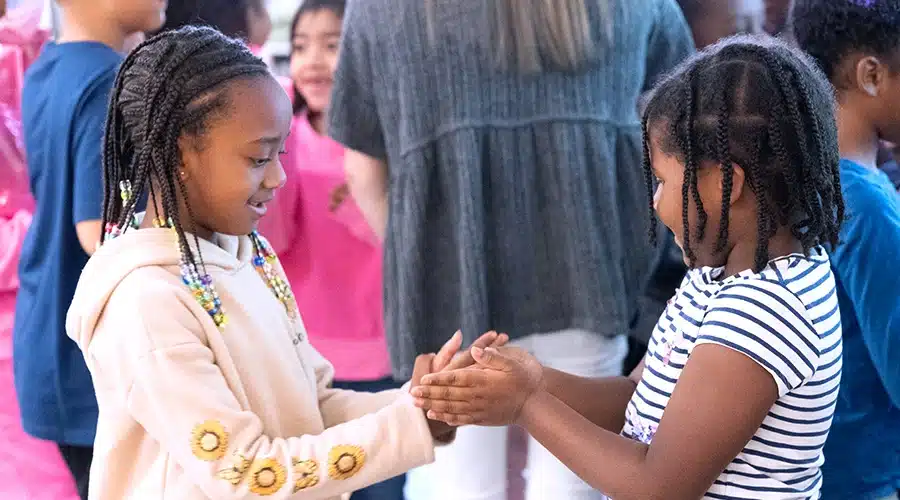
You know it instinctively, you see it every day in your classroom, and brain research supports it: Children learn better when we give them mental and physical breaks from intensive instruction. Just two or three playful minutes of moving, breathing deeply, laughing together, and singing or chanting relaxes children’s bodies and clears their minds for more learning.
Energizers are quick, whole-group activities that can be done anywhere and anytime in the school day. They can be lively or calming. They can have an academic component or can be just for fun. They can be used to transition children between learning activities, as a pick-me-up during intensive lessons, as a way to keep order during times of waiting, as a focusing tool to use when students are outside the classroom, and in many other ways. Energizers can be done with students in a circle, at their desks or tables, or even while they’re waiting in a line. What a gift—joyful, purposeful, engaging activities to help ease students through the school day!
Energizers can be used for many reasons, but their primary purposes are to provide:
Here are three energizers that work equally well with the children at their tables or desks, circled up, or waiting in line. Try them:
An old favorite song with a twist. Grades K–2
For the first few times, simply teach the words and tune of the song. (Remember, just singing together can be very energizing!) Once the students are comfortable with the song, introduce the challenge of this song-game. You can also do some teaching on the meaning of the word “bonny.”
The Words
My Bonny lies over the ocean
My Bonny lies over the sea
My Bonny lies over the ocean
So bring back my Bonny to me.
Bring back,
Bring back,
Oh bring back my Bonny to me, to me.
Bring back,
Bring back,
Oh bring back my Bonny to me.
The Actions
Begin by sitting and singing the song together. Whenever you sing a word in the song that begins with the letter “B”, alternate your position from sitting to standing, and remain in that new position until the next “B” word comes along.
Continue as much as desired, speeding up the song for an extra fun challenge.
Variation
Count off by 2s. Have the 1s begin by sitting, and the 2s begin by standing. Then watch and enjoy as the children bob up
and down opposite one another.
Grades K–6
This silly movement chant will get everyone giggling. It’s most often taught in a circle, but it can be done anywhere. Students will need space to move their arms from left to right, and space to bend forward. Discuss and practice how to do this safely and still have fun.
The Words
The group starts off chanting these words together, and then repeats the words together after each movement instruction from the leader.
Aroostasha!
Aroostasha!
Aroostasha-sha!
Aroostasha!
Aroostasha!
Aroostasha-sha!
The Actions
Start with hands clasped in front of you. As you chant, move your hands from right to left, pulsing them to the beat.
Repeat, and add another movement:
Leader(s): Thumbs up! Group echoes: Thumbs up!
Repeat Aroostasha chorus
Continue, each time adding another movement:
Leader(s): Thumbs up! Group echoes: Thumbs up!
Leader(s): Wrists together! Group echoes: Wrists together!
Repeat Aroostasha chorus
Possible movements to add on:
Elbows in!
Knees together!
Toes together!
Bottoms up!
Tongue out!
Variations
Divide the class into two groups. One group can be the “Aroostasha Leaders,” deciding together beforehand what actions they will demonstrate. Be sure to first brainstorm appropriate motions that the group can do safely yet creatively.
Children can also be invited to be individual leaders.
You might choose to eliminate the “tongue out” motion if you have speech impaired children in your class.
Grades 4–6
The Actions
Teacher (or student) stands facing classmates. This leader calls out a command. Students must follow the previously given command, not the immediate one.
The Words
Leader says: “Stand on one foot!”
Students do nothing.
Leader says: “Hop on one foot!”
Students stand on one foot.
Leader says: “Flap your arms!”
Students hop on one foot.
Leader says: “Pat your head!”
Students flap their arms.
Leader says: “Sit down!”
Students pat their heads.
Leader says: “Fold your hands on your desks!”
Students sit down.
Leader says: “Fold your hands on your desks!”
Students fold their hands on their desks and are ready for the next lesson or activity of the day.
Variation
To add more challenge, the leader may pantomime the motion as well as say it.
Learn even more energizers with Energizers! 88 Quick Movement Activities that Refresh and Refocus and 50 More Energizers! Purposeful Play That Leads to Learning